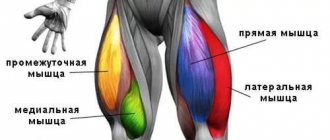While working on the physical development of their child, some parents think about how to teach their child to do the splits. This, of course, is not necessary, but it will help the baby’s body become more flexible, stronger, and the preschooler himself will gain self-confidence, because he will be able to do what not all children from his group in kindergarten can do. Experts note that if the baby is healthy, has no medical contraindications and wants to learn a new skill, then you can safely start classes.
Features of children's twine
Muscle and connective tissues in children are softer and more pliable for various types of manipulation. Therefore, making twine is much easier for children than for us adults. But, despite this feature, we should not forget that their muscles are not plasticine. You need to gradually put your baby on the splits. You should also remember about some psychological nuances. Not all children want to stretch and waste their time of carefree play on exercise.
Therefore, think carefully about your child’s motivation and how your classes will be held. If you decide to send your child to a specialized sports section or club, make sure the qualifications of the teacher and familiarize yourself with the conditions in which you will have to practice. Home training is received with great enthusiasm by many children. This is the time to spend with your parents. It is important that the child enjoys studying. Otherwise, you will expect childish rebellion and the absence of any results.
Before you start stretching, you need to decide on the type of twine: longitudinal or transverse. The set of exercises that will make up a deep stretching complex will depend on the type of splits. Longitudinal twine is much easier to perform. Try to master this particular exercise first.
Another nuance that is worth paying attention to is that the child, at the initial stage, cannot stretch on his own. He needs help, both physical and psychological. Therefore, it is best to do all the exercises together, insuring the baby and making sure that they are performed correctly. This will not only allow you to achieve the desired results faster, but also avoid unnecessary injuries.
Twine technique
This exercise should be done if stretching does not cause pain. It is important that classes run smoothly. Parents should not artificially stretch their children, everything should be natural. A little pain is acceptable. However, you should not allow severe pain.
Longitudinal twine at home is done like this:
They get down on their knees. Legs are stretched one by one
It is important to lower your pelvis as much as possible. The baby's back should be straight.
Of course, it may not work out the first time. But regular training gives excellent results. Over time, the exercise will get better.
Cross twine is made as follows:
- Standing, legs spread wide.
- Your arms should be extended forward.
- Over time, the distance to the floor is reduced.
After a few sessions, positive results will be noticeable. At first, your client needs to be supported a little by the shoulders, but it is forbidden to forcibly stretch
It is important that classes are enjoyable, so classes should be conducted to rhythmic music
Parents should praise the child even for small results and efforts, as this will be a strong motivation to continue working. You should not scold him or compare him with other kids, since all children are different.
There are several tips without which you cannot conduct children's training:
- For classes you need a warm room. Cold has a negative effect on muscle elasticity. The training will not be very effective, and the risk of injury increases.
- Suitable clothing required. It should be neither tight nor loose. It is better to choose cotton T-shirts, leggings, and gymnastic swimsuits. And you don't need shoes; stretching is usually done barefoot or wearing cotton socks.
- Classes should be conducted regularly, as this is the only way to guarantee success. It's best to train daily.
- Before starting work on stretching, it is advisable to consult a specialist. He will create a suitable training program and select suitable types of training.
Experts recommend: if a child cannot do the splits even with effort, he should not be forced to do it. In this case, stretching exercises are suitable - they are useful, but will not make you feel like a failure. No need to wait for an immediate effect. Only with regular training will you be able to achieve success and not harm the baby.
Best age to learn the splits
Twine is very useful for children. But at what age can you start training so as not to cause harm? Experts recommend starting to stretch at the age of 5–7 years. During this period, a person’s muscles and ligaments are most susceptible to influence. Thanks to this property, training is less painful and more effective. In addition, at this age children can already consciously perform exercises.
Due to increased natural activity, some children respond poorly to static exercises. They get bored. Take into account amplitude movements: leg swings, lunges, etc. Such movements are perceived with great interest, and stretching occurs due to muscle work. The main thing is to try to increase the amplitude in every movement.
Three Types of Stretches to Develop Flexibility
- Passive stretching. The slowest type, involving complete control over the muscles. To do this, the application of force must be long-term and external - that is, provided by a simulator, an exercise partner, or some kind of load. Its goal is to stretch the ligaments and muscle fibers as much as possible, but with virtually no pain.
- Active stretching. With it, the force is achieved through its own movement. At the same time, the muscles contract more actively, and the tension is at the limit of the athlete’s capabilities.
- Ballistic stretch. Ballistics is aimed at movements with acceleration, and therefore requires experience and extreme attention (otherwise you can tear muscle fibers and damage joints). However, it is also necessary, since the types of loads on the muscles should not only be static.
The benefits of children's stretching
This article deals exclusively with the amateur type of load. When classes with a child are carried out for his harmonious physical and psychological development. Thanks to such training, children’s backs are strengthened, their posture is leveled, and all muscle groups are toned.
Stretching to the splits helps relieve psychological fatigue and tension. This is especially important for schoolchildren who are overloaded with tasks today. Relieving tonic tension during training helps stimulate brain function.
Thanks to regular exercises for 20 minutes, the child will begin to absorb information more easily, anxiety will decrease, and immunity will improve.
What is flexibility and what does it depend on?
It is impossible to understand how to pull the twine correctly without knowing what flexibility is and what it depends on. Thus, joints are movable connections of the bones of the skeleton. The movement of joints relative to each other is carried out with the help of muscles. Flexibility is the ability of joints to become more flexible and increase their range of motion. Flexibility can be active or passive.
Active flexibility is the ability to perform movements with greater amplitude due to the activity of the corresponding muscle groups.
Passive flexibility is the development of maximum joint mobility under the influence of external tensile forces, for example, the efforts of a partner, external weights, or through the use of special stretching devices.
Lower body stretching is about passive flexibility, where you gradually increase the mobility of your joints through various exercises.
There is an opinion that the activity and mobility of large articular joints increases in childhood. Then it remains unchanged for a couple of years and then decreases. However, many adults can regain their former flexibility through regular stretching.
Where to start stretching for splits
Any workout should begin with a warm-up. Despite the fact that children's muscles have increased plasticity, they still need pre-warming.
Any active exercises are perfect for this: running, jumping, dancing. Anything that will make the young gymnast actively move and his muscles work. But remember that our task is not to exhaust the child, but to prepare him for further stretching. The optimal time for warming up is 5 – 10 minutes. Come up with your own exciting method. This could be a set of movements to your favorite song or some kind of game. This approach will make your classes more interesting.
We also pay attention to the fact that you should start training with a “basic complex”. We will present it below. These exercises prepare the body to fully stretch the legs. Basic exercises for children are very similar to those performed by adults. But they need to be done with greater caution. The child cannot yet correctly assess the capabilities of his body, and this can lead to injury.
Before you start doing the splits
And yet, how to do the splits for beginners for children? First, you need to think about what clothes your child will wear for training. The shape should not be tight, comfortable and elastic. Choose non-slip shoes.
At the very beginning, before training, the muscles need to be warmed up. Running, jumping, and squats are suitable for this. You can use a jump rope or a ball. You should warm up in a playful manner for at least five to ten minutes. After the blood has dispersed a little, you can begin stretching.
Children's split stretch
Children master the splits much faster and easier. Their body is still developing, and favorably perceives this kind of load. The main thing is not to overdo it. Remember that it is very easy to overdo it. But eliminating the consequences is the opposite. It is not without reason that professional gymnasts have many diseases that are associated specifically with stretching.
Pay attention to how the child reacts to a particular exercise. If you see that he is in pain, reduce the impact. If your baby doesn’t do a certain movement willingly, try changing it to another exercise. Don't be afraid to experiment. It is very important that training is enjoyable. Only in this case will the child return to them and achieve good results.
Final stage
After the child has sat down on the splits or tried to sit down, having finished the exercises, he should shake his arms and legs and stretch them to relax the muscles and joints. The child should be given rest to allow the muscles to recover.
If you still have a question about how to quickly do the splits for your child, following the recommendations, then you should keep in mind that you need to work with your child for half an hour a day, and in two weeks your baby will do the longitudinal and transverse splits freely and easily.
Recommendations
Now let’s outline a few important rules that relate to children’s training:
- Remember that the room where the classes take place must be warm. Cold does not have the best effect on muscle elasticity. Exercise becomes less effective and the risk of injury increases.
- Choose the right clothes. Too tight or, conversely, loose fit can interfere with exercise and cause discomfort. Cotton T-shirts, leggings, and gymnastic swimsuits are suitable. But with shoes everything is much simpler; we don’t need them. Stretching is traditionally done barefoot, or wearing cotton socks.
- Correctly performed exercises should not be accompanied by pain. Only slight muscle tension is acceptable. Observe your child carefully and ask about his feelings. The impact should be constant, but not sudden.
- As mentioned above, any stretching should begin with a warm-up. Don't neglect this rule
- The key to the success of any training is regularity. It's best to stretch daily.
- Any stretching exercise is performed in four stages: assume a pose, stretch, exit the pose, and rest. Be sure to take a break between exercises.
- Before you begin working on stretching, consult with a physical therapist. He will help you create the right training program and select the appropriate exercises.
How to do cross splits for children and longitudinal splits
Every time before children do the splits, it is necessary to perform muscle stretching exercises. They should be done for at least ten minutes. Stretching exercises are given below:
- Mandatory daily exercises should include leg swings. This is how they are done. The child stands sideways to the chair. One hand holds on to the back of the chair, the other on the belt. Swing your legs alternately to the side, forward and backward. It is necessary to ensure that the knees do not bend, the child pulls his toes forward, and his back is straight.
- Static stretching. The child needs to be shown exercises with bending forward. When doing this exercise, while bending over, you should try to put your palms on the floor and hold, then return to the starting position again. Repeat at least 10 times.
- Stretching exercise near a chair. Bend your right leg back at the knee. Grab it with your right hand and pull your heel towards your buttocks. Then change: clasp your left leg with your left hand. Repeat at least 5 times with each leg.
- Lunges with legs alternately. One leg in front, knee extended so that an obtuse angle is formed between the leg and the floor. Do not lift your heel off the ground. You can complicate the exercise: for example, place your right arm and shoulder under the knee of your right leg. Slowly swing your body, preparing for the cross split.
These were exercises to help a child do the splits.” If the preparation has been made, the stretching exercises have been completed, you can try. The child needs to sit on the splits slowly and carefully, while trying to stretch. There should be no sudden movements. You can support the baby by the shoulders. The pain when stretching on the splits should not be severe. In no case should you be forced to endure, otherwise, after severe pain, the child will not exercise anymore.
Basic exercises for children's stretching
All the exercises described below are perfect for children of different ages. Gradually, when the child adapts, it can be supplemented with elements of deep leg stretching.
"Cat"
This name is familiar to all yoga lovers. We get on all fours, head pressed to chest. As we inhale, we raise our head up (look at the ceiling), and bend our back down. The stomach reaches towards the floor. As you exhale, lower your head down, arch your back upward, and pull your stomach under your ribs.
You need to repeat the cycle 10 times.
Stretch your shoulders and triceps
This exercise can be done either standing or sitting. We place one hand behind the back over the head, the second through the bottom. We try to clasp our hands behind our backs. Then we change hands.
Try to stay in this position for 15 to 30 seconds.
Pull the top of the body
Hands are clasped behind your back. We turn our elbows inward. There should be a feeling of tension in the shoulder blades and upper back. We stay in this position for 15-20 seconds.
Stretch your hips
We stand straight. We bend one leg, slowly lift it up and at the same time begin to lean forward. The back remains straight. We repeat the same movement with the other leg.
Runner's stretch
We take a wide step forward, fixing the body in a lunge. Using short movements, we try to lower the pelvic area to the floor. We do 10 - 15 springs down, after which we do the same with the second leg.
Organization of classes
First, kids learn to perform longitudinal splits, then they begin to perform transverse splits.
It is very important to avoid painful sensations and not to force the child to do it by force, literally clenching his teeth - this approach does more harm than good. Of course, the parent will achieve his goal, but the baby will not experience the joy of success
We also note the importance of warming up, which should be done both before stretching exercises and before performing the splits itself. It includes several simple exercises:
- running in place;
- jumping;
- vigorous bending to the sides;
- squats.
After the warm-up, perform a set of stretching exercises
It is very important to exercise regularly in such a way that there is progress, that is, gradually increase the number of repetitions and improve the result. If today the baby managed to bend over and reach the floor with his hands, then it is very desirable that tomorrow he does it a little better or is able to fix the position a second longer
Harmful stretching for children.
The only negative side is that if a child does not exercise for his own pleasure, then such a load will only be harmful.
This happens because the child’s body is not ready for a heavy load, and during stretching classes for children, many trainers use “force” and force the children to exercise. As a result, this leads to the child refusing to study and losing interest. In addition, in the future this can lead to the development of diseases of the musculoskeletal system, osteochondrosis, etc. Therefore, we recommend that you pay attention to your child's wishes.











